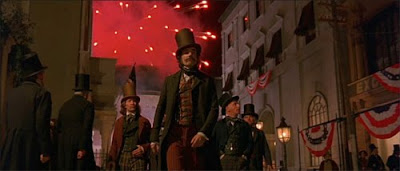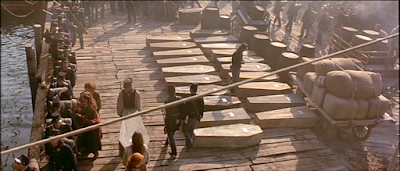At the end of Ti West's House of the Devil (2009), I had two thoughts. First, that it was the kind of movie Lucio Fulci spent the early eighties making (including Fulci's eyeball violence!). My companion for this film corrected me by noting that Fulci never directed anything as coherent as this film. She has a point. Second, this was a far better genre reconstruction than either half of the Grindhouse double feature. Those films were far too knowing. This film is deadly serious. Its jokes are almost entirely found in the formal elements rather than in the text or the subtext. For that matter, it makes far better use of familiar genre actors like Mary Woronov and Dee Wallace by virtue of giving them actual parts rather than giving them walk-on cameos as post-modern winks at the audience.

Anyway, I'm getting ahead of myself. This movie is a loving reconstruction of the sort of horror movies that were made in the late 1970s and early 1980s. In terms of tone, pacing, story construction, and payoff, this is a film that would be comfortable on a double bill at a declining drive-in or on HBO at about 2:30 a.m., back when HBO was still desperate for content and showed all kinds of movies. It has a wintery existential look that suggests a film made in Canada as a tax break, if you know what I mean (it was, in fact, made in Connecticut).

The plot isolates a college student (Jocelin Donahue) looking to make money for a new apartment by accepting an unusual and unusually lucrative babysitting offer on the night of a full lunar eclipse. Her employers (Tom Noonan and Mary Woronov) are the kind of creepy senior citizens that befriended Rosemary Woodhouse back in 1967, which should tell you all you need to know about the plot. Tom Noonan needs to be in more movies, by the way. So does Mary Woronov.

For the most part, Jocelin Donahue does a fine job as Samantha, our heroine. It doesn't hurt that her character is wholly believable. She doesn't do anything obviously stupid, and her motivations for what might arguably be her stupidest act--when she ultimately takes the job offer--are completely justified. You can see her longing to be out on her own in the first shot to show her face (a characteristically long take comes up on her from behind as landlady Dee Wallace extols the apartment she's trying to sell her). This is set up really well. The cruel fate of Samantha's friend, Meghan (Greta Gerwig) also defies horror movie conventions, in so far as the movie doesn't seem to hold any kind of moral judgment towards her (nor should it). But then, this film has a different genealogy than that. It's not descended from the slasher movie, in spite of its "babysitter on her own" set-up.
As a formal exercise, this is a pretty tightly controlled movie. Director West, who also wrote and edited the film, shows a talent for squeezing every ounce of dread out of his long takes, and sets things up so that when the first real shock of the film happens, it's as abrupt and brutal as a bullet into your temple. More than that, though, the film has a weirdly depopulated feeling that is as isolating to the audience as it is to its central character. For the most part, the suspense the movie builds makes a promise to the audience that the payoff can't possibly keep, but it tries gamely enough with what it has. You could even argue that the end of the movie is a feminist rebuff to the normal ending of devil movies, in which the heroine takes the responsibility for her body into her own hands, though that might be stretching things a bit. In any event, if you're a long-time fan of the horror movie, the journey is pleasurable enough as it is, and, hell, those films from the eighties did the same things with their endings most of the time. And this one has a better soundtrack.



















